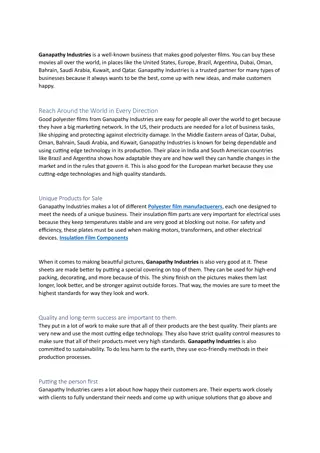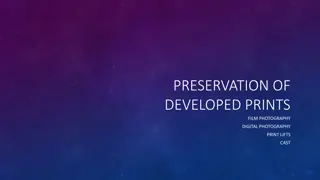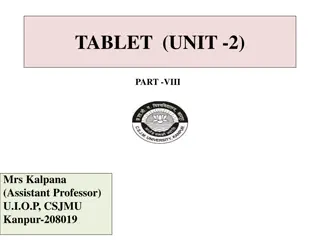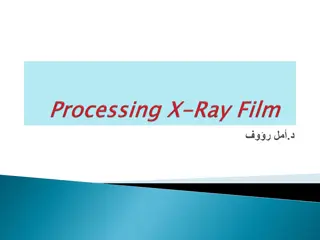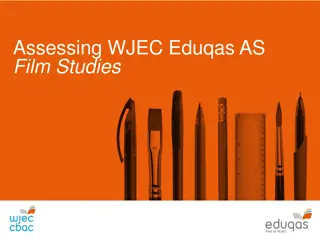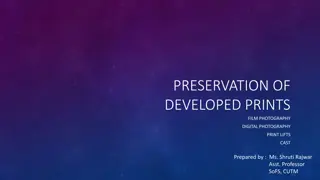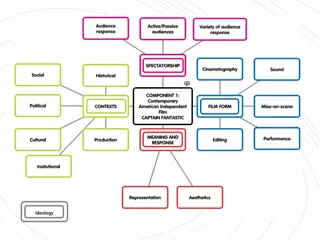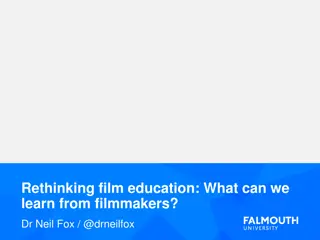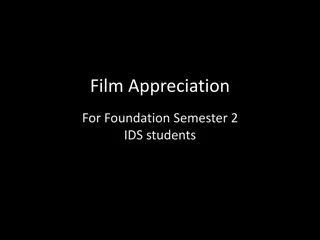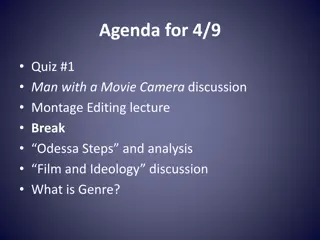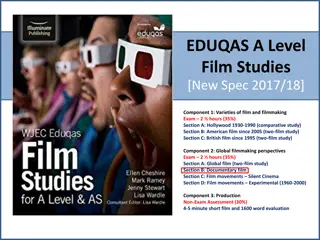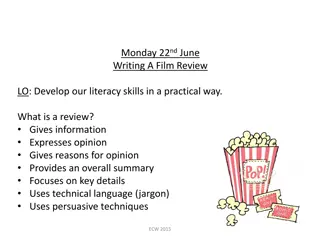Understanding Spectatorship in Film Studies
Explore the active role of spectators in creating meaning and emotional responses in films. Discover how filmmakers manipulate viewers and how audience expectations, spectator positions, and cultural factors shape various responses to films. Dive into the concepts of active and passive spectatorship, different readings of films, and the impact of individual frameworks of interpretation on film understanding.
Download Presentation

Please find below an Image/Link to download the presentation.
The content on the website is provided AS IS for your information and personal use only. It may not be sold, licensed, or shared on other websites without obtaining consent from the author. Download presentation by click this link. If you encounter any issues during the download, it is possible that the publisher has removed the file from their server.
E N D
Presentation Transcript
Captain Fantastic Component One Section B American Film
Core Elements of Film Form Elements of Film Form Meaning and Response The contexts of film
Spectatorship It could be argued that all spectatorship is active, as the spectator is a co-creator of meaning and the person who produces response, both intellectual and emotional. The attempted manipulation of the spectator by filmmakers through the use of well-known film techniques is a potential key area of focus for the study of spectatorship. Alongside this, learners should study both their position within the narrative and the structure of the narrative as a further manipulation technique. It is recommended that learners study the elements of film form closely through key sequences to analyse spectator response as well as studying the films' narrative.
Spectatorship A central part of Film Studies is how films address individual spectators to engage their interest and emotions through, for example, particular shots, editing and music as well as narrative and genre. Films are generally constructed to provide the spectator with a particular viewing position, most often aligning the spectator with a specific character or point of view. This in turn raises questions about how 'active' or 'passive' spectators are in their responses to film. Despite the viewing positions offered by film, not all spectators respond in the same way, mainly as a result of social and cultural factors.
Spectatorship In summary The concept of passive and active spectatorship How spectators interact with narrative How spectators respond to the key elements of film form How and why spectators respond differently to the same film Preferred, negotiated, oppositional and aberrant (unintentional/not typical) readings of films
Audience expectations Watch the introduction: Where is the film set? What have you seen in the mise-en-sc ne that places the action in the past? Present? Future? Why do you think the filmmakers have done? Cinematography Opening shots, extreme long shots of long duration to establish and romanticise the grandeur of the natural world. Discuss the shots used during the hunt and kill of the deer- how is the kill represented within this sequence?
Frameworks of Interpretation Our understanding of film and its meaning can be affected by many different things. These include: - Age - Gender - Social Status - Ethnicity - Education - Past Experiences
Big Questions What are the main messages and values of the film? How are these messages conveyed through the use of the key elements of film form? Does the film reinforce, challenge or reject dominant attitudes within the society it is made in? What films/TV shows have similar (or different messages)? Which character(s) are the spectators encouraged to align themselves with and what is their dominant belief system?
Spectatorship and Captain Fantastic Although the film does not completely encourage identification with Ben it does at key moments of grief e.g. his hallucinations of his deceased wife are shot using close up point of view shots encouraging identification. The film represents two very different approached to life, Ben s and Jack s, and invites the spectator to consider the pros and cons of each. Therefore the spectator s own experiences and ideologies will have a profound impact on the view they leave the film with.
Preferred, Negotiated and Oppositional Readings Stuart Hall was part of The Centre for Contemporary Culture (also known as the Birmingham School) who in the 1970s was amongst the first Media Studies academics in the UK. He said audiences created meaning from a text in three main different ways. Firstly, the creator of the text encodes an intended meaning. The reader then decodes the meaning. The preferred meaning is the one intended by the author. But there may also be a negotiated meaning - where the reader recognises the intended meaning but may not entirely believe or accept the message. There is also an oppositional or aberrant reading, where the viewer may deliberately reinterpret or mistake the meaning, creating a new message/response from the text.
Preferred, Negotiated and Oppositional Readings Prepare a series of comments about Ben (the father) and Jack (the grandfather). Use the following headings and come up with additional ones of your own: Lifestyle Choices Beliefs (political, religious and education system) Parenting Skills Life/ world view Relationship to society
Preferred, Negotiated and Oppositional Readings Copy out the following quotations taken from reviews of the film. Discuss how far you agree/ disagree, giving detailed reasons for your opinions: Ben is a a loving father who is unafraid to face the world naked and yet touchingly ready to grapple by the possibility that his arrogant, free spirit might actually do harm to his children. Rolling Stone He treats his five kids as though they are military recruits (as well as PhD candidates). Because they are children, and cut off from other influences, they parrot back to him his words, they share his worldview without question. It's Family as Cult. The Guardian Ben is raising his kids to question the status quo, to not swallow any information wholesale, and yet he creates an environment where questioning his authority is impossible. The Guardian
Using the ideas of Stuart Hall, we can classify a range of different audience responses: the preferred reading, the negotiated reading, and the oppositional meaning. Preferred meaning: Ben and his family are outlaws without committing crimes ; outcasts who have created a community of like-minded spirits to live apart from the hypocrisies of the modern world rejecting America s consumerist culture and organised religion. Negotiated meaning: Ben and his family resembles the counter-cultures of the 60s and 70s, where free- spirited people lived off grid and created their own alternative to mainstream society. Unfortunately, many of these communities ended up attracting criminal or abusive people. If the adults of the Bathtub want to live like this, that s fine, but it s not a suitable environment for children. Oppositional meaning: the Bathtub residents are (in words of LA Review of Books) apolitical, individualist hedonists that don t represent what people from very poor underdeveloped communities are actually like. The film represents a romanticised and idealistic pastoral fantasy of the filmmakers.
Captain Fantastic and Spectatorship Matt Ross, I didn t want to vilify anyone. No one in this film is the villain. When I met Frank Langella, I told him [his character] is antagonistic towards Viggo s character but that he is not the antagonist. That would have been boring. [His attitude to the kids upbringing] comes from love. His love is different but just as legitimate. Audience expectations play a significant role in creating a spectator s response and this film being an art-house film and festival success may have created an expectation that its politics will be clearly liberal and left-leaning. The more balanced approach to ideology within the storytelling may therefore provide an interesting challenge to some audience expectations. Absence of female identification. Star persona of Viggo usually an object of 'female gaze'. Not here.
Film Form Sound: use of diegetic or non-diegetic sound (which may include foley sound or other expressive uses of sound) and what filmmakers communicate by their use how either diegetic or non-diegetic sound relates to characters or narrative how sound conveys messages and values Some candidates may consider how sound can generate multiple connotations and thus suggest a range of interpretations which may be an indication of Band 4 or Band 5 responses. Editing: shot-to-shot relationships of continuity editing and how they're created (which may include match editing, and the use of 180 rule) how editing implies relationships between characters and contributes to narrative how editing conveys messages and values how visual effects (created in post-production) are used Some candidates may consider how some editing effects can generate multiple connotations and thus suggest a range of interpretations.
Editing: shot-to-shot relationships of continuity editing and how they're created (which may include match editing, and the use of 180 rule) how editing implies relationships between characters and contributes to narrative how editing conveys messages and values how visual effects (created in post-production) are used Some candidates may consider how some editing effects can generate multiple connotations and thus suggest a range of interpretations.
Spectatorship Responses Candidates may discuss some of the following to indicate their understanding of active and passive film viewing: active film viewing implies involvement and engagement by the spectator, actively thinking about and interpreting what's seen and may also involve active questioning of what filmmakers offer passive film viewing implies a lack of conscious involvement, passively absorbing what's seen without conscious interpretation or questioning passive film viewing could be conceived as film spectators responding in the way filmmakers through a range of filmmaking techniques 'invite' them to respond (the way they encourage alignment and position spectators) film viewing could be seen as covering a spectrum between active and passive response, which spectators fluctuate between in their film viewing. This conception of film viewing may indicate Band 4 or Band 5 answers.
Spectatorship Responses Responses should include: discussion of short sequences or examples of shots to suggest how filmmakers use cinematography, mise-en-sc ne, editing or sound, or equally narrative structure and generic conventions to encourage spectators to respond in particular ways, including taking up particular points of view a claim that spectators respond either mainly actively or mainly passively (Either of these points of view is acceptable provided the candidate is able to support their views by close reference to the film studied. The strength of the answer is likely to depend on how convincing a case can be made.) a claim that film viewing does involve a combination of active and passive viewing (Some candidates may recognise there could be a contradiction between an active response - 'rationally' questioning what filmmakers suggest - and a passive, emotional submission to the film - 'emotionally' accepting a point of view.) some formalisation of how spectators respond by referring to spectator alignment or how spectators are positioned. (This may be expressed in terms of preferred, oppositional and negotiated readings, following Stuart Hall's audience response theory. Such responses are likely to indicate responses in Band 4 or 5.)








